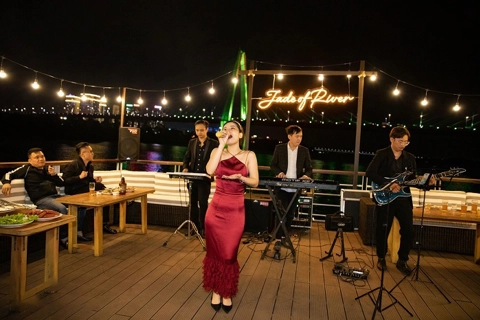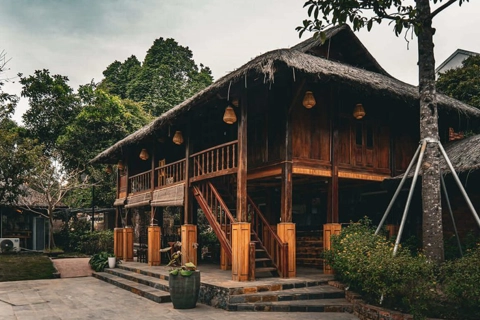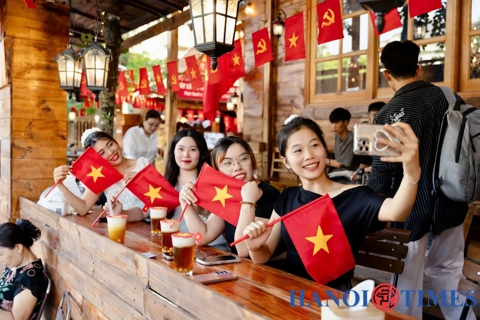Travel
Tour retraces a classic novel
Feb 21, 2015 / 11:15 AM
When I visited Nhan Hau Village, I felt I was walking into the pages of Chi Pheo, the Vietnamese literature classic about northern farmers in colonial-feudal society.
Just as author Nam Cao (1915-51) found inspiration in the lives of villagers to write the story, the writer inspired contemporary tour operators to launch a tour for people to discover the local life and understand the story more deeply.
Chi Pheo takes place in Vu Dai Village, which is modeled after Nhan Hau Village, previously known as Dai Hoang Village. The village is located in Hoa Hau Commune in the northern province of Ha Nam, 40km from Ha Noi.
The village appeared in front of our eyes with tiled roofs hiding among green bamboo leaves.
Tour operator Hoang Thi Thu Dieu from Khat Vong Viet Company led us to old houses that belonged to writer Nam Cao and Ba Kien, a character in Chi Pheo. There we had a chance to learn about the story's context thanks to Tran Huu Vinh, the keeper of writer Nam Cao's memorial house, who is also the writer's nephew.
Based on the lives of some people living in the village, the novel focuses on Chi Pheo, a good farmer imprisoned because of tyrant landlord Ba Kien. After going to prison, Chi is deprived of his human appearance and his life becomes tragic. He turns into a desperate drunken man reacting to life with curses.
Then the scoundrel excluded from society falls in love with Thi No, the ugliest woman in the village, who kindly cooks him a bowl of onion rice soup when he is sick. The action touches Chi's heart and he seems to be reunited with his true good nature. However, the couple and their love aren't recognised and once again Chi falls into despair. He kills Ba Kien for revenge and then commits suicide.
In real life, Ba Kien died due to old age. However, Vinh told us about the stormy lives of some people living in Dai Hoang Village at the end of the 19th century, which inspired the writer to create the story.
The State has had a policy to protect Ba Kien's house since 1988, as it represents the traditional architecture of houses in the northern region with a tiled roof, three partitions, two wings and 16 pillars carved in sophisticated style.
After the tour, tourists get the chance to enjoy the famous speciality of Nhan Hau Village, braised fish, and learn how to cook it.
Tran Ba Luan, owner of Tran Luan braised fish company, claims to serve the most delicious fish in Viet Nam.
"We select fresh black pikes for the dish and cook them in a terracotta pot for 24 hours," he said.
We were guided to chop firewood from the longan tree and prepare the fire with straw. Luan also helped us make the sauce from lemon, ginger, chili, pepper, onion and crab extract, which created the wonderful taste and fragrance for the dish.
Cooking the fish was the most memorable moment for us, as we were accustomed to using gas stoves and had never cooked with straw and firewood.
The Nhan Hau Village banana gardens where Chi Pheo and Thi No dated are filled with king bananas, a special variety with small yellow fruits, thin skin, sweet taste and lingering scent. We were told that the banana was once an offering to the king.
Nam Khanh from Ha Noi and his wife tried on clothes of Thi No and Chi Pheo and took photos in the banana garden with their two children.
"The couple didn't have a happy ending. Now happy couples and families can join the tour and write a different end for the story," he said.
As a literature lover, he drew pleasure from touching Ba Kien's house and walking on roads where Chi Pheo walked. He suggested that the tour would be good for students who were reading Chi Pheo's story at school.
"Like me, they would feel the story and characters' lives thoroughly," he said.
The idea for the tour came from Nguyen Thi Thu Hanh, director of the Scientific Union for Sustainable Tourism Development.
"This is the first literary tour in Viet Nam," she said. "It will help tourists understand more about satirical literature of Viet Nam in the 19th century, its value and meaning, as well as the life of Vietnamese farmers in the era."
Hoa Hau Commune Party Committee Secretary Tran Duc Huy said local people had been waiting for such a project for a long time.
"The project takes advantage of local resources," he said. "Developing tourism helps improve the local economy so people can have a chance to sell their specialities such as braised fish, banana and seedless persimmon."
He's right. We left the village with not just memorable experiences, but also pots of braised fish.
Chi Pheo takes place in Vu Dai Village, which is modeled after Nhan Hau Village, previously known as Dai Hoang Village. The village is located in Hoa Hau Commune in the northern province of Ha Nam, 40km from Ha Noi.
The village appeared in front of our eyes with tiled roofs hiding among green bamboo leaves.
Tour operator Hoang Thi Thu Dieu from Khat Vong Viet Company led us to old houses that belonged to writer Nam Cao and Ba Kien, a character in Chi Pheo. There we had a chance to learn about the story's context thanks to Tran Huu Vinh, the keeper of writer Nam Cao's memorial house, who is also the writer's nephew.

Time capsule: Ba Kien's house, an old house recognised by the State as a relic to be protected because it represents the traditional architecture of Vietnamese homes in the north.
|
Then the scoundrel excluded from society falls in love with Thi No, the ugliest woman in the village, who kindly cooks him a bowl of onion rice soup when he is sick. The action touches Chi's heart and he seems to be reunited with his true good nature. However, the couple and their love aren't recognised and once again Chi falls into despair. He kills Ba Kien for revenge and then commits suicide.
In real life, Ba Kien died due to old age. However, Vinh told us about the stormy lives of some people living in Dai Hoang Village at the end of the 19th century, which inspired the writer to create the story.
The State has had a policy to protect Ba Kien's house since 1988, as it represents the traditional architecture of houses in the northern region with a tiled roof, three partitions, two wings and 16 pillars carved in sophisticated style.
After the tour, tourists get the chance to enjoy the famous speciality of Nhan Hau Village, braised fish, and learn how to cook it.
Tran Ba Luan, owner of Tran Luan braised fish company, claims to serve the most delicious fish in Viet Nam.
"We select fresh black pikes for the dish and cook them in a terracotta pot for 24 hours," he said.
We were guided to chop firewood from the longan tree and prepare the fire with straw. Luan also helped us make the sauce from lemon, ginger, chili, pepper, onion and crab extract, which created the wonderful taste and fragrance for the dish.
Cooking the fish was the most memorable moment for us, as we were accustomed to using gas stoves and had never cooked with straw and firewood.
The Nhan Hau Village banana gardens where Chi Pheo and Thi No dated are filled with king bananas, a special variety with small yellow fruits, thin skin, sweet taste and lingering scent. We were told that the banana was once an offering to the king.

Tried and true: Ingredients to cook braised fish, a speciality of Vu Dai Village with wonderful taste and fragrance.
|
"The couple didn't have a happy ending. Now happy couples and families can join the tour and write a different end for the story," he said.
As a literature lover, he drew pleasure from touching Ba Kien's house and walking on roads where Chi Pheo walked. He suggested that the tour would be good for students who were reading Chi Pheo's story at school.
"Like me, they would feel the story and characters' lives thoroughly," he said.
The idea for the tour came from Nguyen Thi Thu Hanh, director of the Scientific Union for Sustainable Tourism Development.
"This is the first literary tour in Viet Nam," she said. "It will help tourists understand more about satirical literature of Viet Nam in the 19th century, its value and meaning, as well as the life of Vietnamese farmers in the era."
Hoa Hau Commune Party Committee Secretary Tran Duc Huy said local people had been waiting for such a project for a long time.
"The project takes advantage of local resources," he said. "Developing tourism helps improve the local economy so people can have a chance to sell their specialities such as braised fish, banana and seedless persimmon."
He's right. We left the village with not just memorable experiences, but also pots of braised fish.








